Rooted in Sardinia: A Deeper Look at Our Vineyard Journey
Explore some of the technical aspects of starting a vineyard in Sardinia and learn about the varieties we planted.
My dearest Sip with Nik cru, last month I shared a behind the scenes look at the highs and lows of planting our Sardinian vineyards with you. In this week’s newsletter, I want to take you even deeper into the dirt—literally. Below you’ll find a detail-rich look at how our vineyards came to life and more of the somewhat technical aspects that went into making these vineyards a reality. If you didn’t get a chance to check out the first vineyard planting story, which includes some of the challenges we encountered along the way, you can find it here.
Cultivating a Dream
Before we dive into all of the juicy details, allow me to tell you a little story. I first arrived in Sardinia in 2018 after Marco and I had our whirlwind romance during harvest in Paso Robles. For our next adventure, we were headed to Australia to work harvest down under, but it was time to meet the parents in Sardinia first. It had been a while since I’d had to “meet the parents” and this time I was especially nervous because we couldn’t even speak the same language yet. They don’t speak English and I didn’t speak much Italian at the time, so the experience was a bit daunting to say the least. You can read about that first Sardinian experience here (and snag a delicious recipe for Sardinian pasta from my mother-in-law while you’re at it).
His family was extremely welcoming nonetheless and even cried tears of joy the first time that we met. So sweet! I was completely swept up in the magic of visiting a new place for the first time and Marco gave me the grand tour of his beautiful island, taking me to visit all of his favorite spots, including a tour of must-try Sardinian wineries.
Side note: if you’re planning a visit to Sardinia and want to go wine tasting, don’t miss my ultimate guide on Where to Go Wine Tasting in Sardinia available in my Food & Wine Guide library.
One of the most memorable moments from that first trip was when he took me to his family’s village and drove me up a steep, winding road into the mountains. We arrived at a beautiful piece of property overlooking the village with a stunning, expansive view of the valley below and mountains beyond. The property was shaped like an amphitheater amidst the mountains, dotted by beautiful old trees and tons of native plants.
Marco showed me around and passionately explained his dream of planting a vineyard there someday. And I could totally see it. Little did I know, that dream would become a reality sooner rather than later. For most people, “one day” may never arrive, but Marco knew what he wanted and with the help of his family, we were able to start making that dream a reality within the next four years.
The Land: Our Sardinian Vineyard Site
Our vineyards are both located around the village of Anela in the Goceano region in north-central Sardinia. Anela is the village where both of Marco’s parents grew up and where they have inherited land from their families over the years. To give you a general idea of the location:
We planted two different vineyard sites, one in the mountains above the village and the other on the valley floor below the village.
We planted just over 2 hectares total between our mountain site and valley site, which is just under 5 acres.
To be precise:
1 hectare = 2.47105 acres
So: 2 hectares × 2.47105 = 4.9421 acres
The Mountain Site: Preda Ortu
Our mountain vineyard site has a south/southwestern facing exposure and encompasses 13,953 square meters, which is around 150,207 square feet. There are a handful of benefits of this exposure that we’re excited about:
Maximum sunlight: the vines will receive more direct sunlight throughout the day, especially in the critical afternoon hours. This helps grapes mature fully, which is essential for sugar development and flavor concentration.
Enhanced ripening consistency: a warmer, sunnier slope promotes more even ripening across the vineyard. This can reduce the risk of under ripe flavors or uneven harvests, contributing to better quality and more expressive wines.
Drier canopy = less disease pressure: Morning and afternoon sun dries dew and moisture quickly, reducing the risk of fungal diseases like powdery mildew or botrytis. This is essential, as we’re aiming to be certified organic eventually and will not be doing chemical treatments.
The vineyard rows are basically planted north to south in line with the natural amphitheater of the terrain so that the canopy will shade the grapes during the peak sun of the day. This site sits at a high elevation of 560-580 meters above sea level (1,837–1,902 feet) with around a 45 degree slope that will allow for excellent drainage. Although it still gets hot up there, the temperatures are usually 5-10 degrees cooler than the vineyard site on the valley floor. Plus, there is pretty consistent wind that flows down through the mountains known as the “Monteresu” that will help moderate temperatures in our mountain site vineyard throughout the growing season.
Decades ago, the area became known as Preda Ortu, which means “rock garden” in the local dialect of Sardo, and the site certainly lived up to the name! Prior to planting, our friend with a massive tractor and excavator helped us unearth massive boulders throughout the property in order to be able to plant. The soil was super rocky when we planted our vineyards and our crew had a difficult time pressing the vines into the ground in some parts of the vineyard. Then, last year we spent a week removing even more rocks from the vineyard that was seriously intensive manual labor. We removed enough rocks to basically make a wall around the vineyard. But it was well worth it because now the land is much more workable.
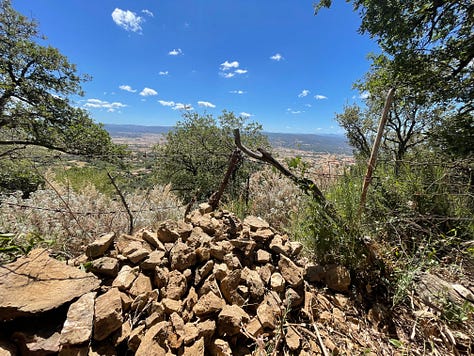
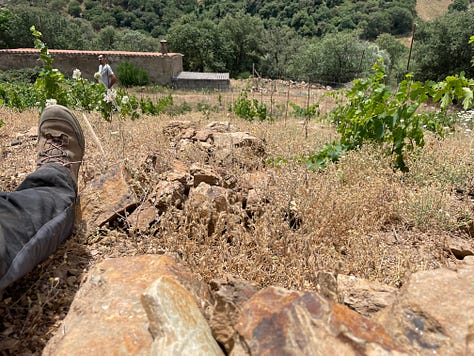
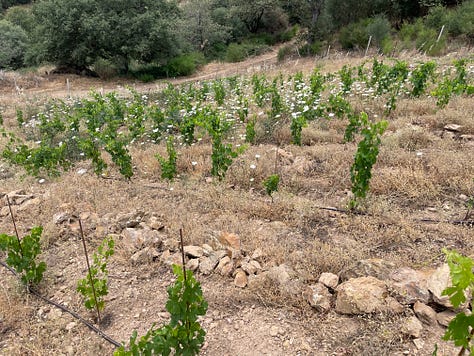


Now, let’s talk about soil at Preda Ortu. We had the soils tested about a year before we planted our vineyards while we were preparing the sites. Here are the results of the analysis in Italian.
The soils in Preda Ortu are mainly:
50% sand
20% limestone
30% clay
Though I don’t see it in the soil analysis, there is also a decent amount of visible schist at the mountain site. They might include that under the clay classification.
Here are some benefits of these soil types:
Sand: good drainage & root penetration
Light, well-draining soil helps prevent waterlogging and promotes deep root growth, allowing vines to develop resilience and gain access to nutrients.
Limestone: promotes acidity, freshness, and mineral-driven complexity
Encourages vines to struggle just enough, which enhances flavor concentration and structure.
Overall well-draining yet encourages some water retention.
Limestone rich soils are famed for producing wines with bright, natural acidity and a long, saline-like finish.
Clay: concentration, structure & water retention
Holds moisture and nutrients, offering a strong foundation for vine health during dry growing seasons.
Contributes to body and tannic structure in wines, which can be especially important for red grape varieties like Cannonau.
Balances the quick drainage of sandy soils, retaining water deeper in the root zone while preventing vine stress in drought-prone seasons.
Schist: heat retention & minerality
Schist’s rocky, fractured layers add excellent drainage and allow vine roots to dig deep.
Absorbs heat during the day and releases it at night, promoting even ripening at higher altitudes.
Wines grown in schist often have a distinct mineral backbone, tension, and age-worthiness.
Why This Soil Combination Works Beautifully
Sand and clay create a balanced water dynamic; fast drainage near the surface with moisture retention below.
Clay and limestone add structure and freshness, key for wines with both power and finesse.
Schist and sand ensure drainage and heat retention, ideal for mountain viticulture.
Together, this soil mix supports deep roots, balanced stress, and expressive terroir, leading to wines with concentration, freshness, and a mineral finish.
Looking at the soil analysis, at this site we seem to be low on available phosphorus and exchangeable magnesium. The latter is held on the soil’s cation exchange sites, meaning it's not locked up in minerals, but rather readily available for plant uptake. It's an important nutrient for chlorophyll production, photosynthesis, and overall vine health and vigor.
This soil analysis was done in 2022, so I’d be interested to see how the cover crops we’ve had planted over the last few years, as well as grazing sheep, etc. have impacted these numbers. I’ll keep you updated!
The Valley Site: Isteleviu
Our valley site lies down on the valley floor below Anela, but it’s not a completely flat site. There is a bit of undulating terrain, though I wouldn’t call it hilly. This site is known as Isteleviu by the locals. It’s unclear what the definitive meaning of the name is, but we think it’s something like “street of the stars” because you can see hundreds of stars from there on a clear night.
The vine rows here are planted east to west so that they will be shaded by the vine’s canopy for most of the day as the sun passes over. The valley site gets super hot during summer, and they are definitely going to need all the help they can get to moderate the high summer temperatures.
Soils in Isteleviu are:
50% sand
25% limestone
25% clay
So, pretty similar to the mountain site, however there is no schist here. I won’t go into all of the benefits of the soil types, since I’ve explained that above. However, from working the land over the last few years, it’s easy to see that it’s a pretty fertile site. All of the rain washes down the mountains to the valley floor (which caused some drainage issues the year we planted thanks to unseasonal rains; drainage issues have since been resolved), bringing nutrients with them I’d imagine.
What We Planted
Alright, let’s explore the Sardinian varieties we decided to plant.
Arvesiniadu: An Under the Radar White Variety We’re Hoping to Put on the Map
At our mountain site, Preda Ortu, we chose to plant only a white variety called Arvesiniadu. This variety is native to Sardinia, particularly in the Goceano area, and is currently undergoing somewhat of a renaissance or revival. When we were selecting the canes to be grafted onto American rootstocks at a nursery the year prior to planting, we visited an older gentleman’s beautiful vineyards in Benetutti, the village just south of Anela. Signore Bitti has been cultivating Arveisniadu for decades and we felt confident sourcing Arvenisiadu from him. He actually has three different biotypes of the variety, evident in the different shapes of the grape clusters. One is small and compact, another is long and sparse, and the third is somewhere right in between the two.
This is a variety that’s just being rediscovered in Sardinia, so Marco hopes for our vineyard to be a resource for anyone who would like to grow or study Arvesiniadu, too. We were very intentional about planting the three different biotypes in their own sections of the vineyard. Plus, it will be very interesting to see how they vary once vinified. So, we’re looking forward to experimenting with them in the coming years. The vines here will be trained as guyot.
Arvesiniadu: Grape & Vineyard Characteristics
Late-ripening variety, making it well-suited to warm, dry climates with long growing seasons.
Naturally high acidity, which helps retain freshness even when picked late and makes for age-worthy wines.
Produces moderate yields, especially in older vineyards.
Often found in traditional mixed plantings for field blends, though some producers are now reviving it for single varietal wine production.
Arvesiniadu: Wine Characteristics
Color: Pale yellow to straw with greenish highlights.
Aroma: Subtle and fresh—notes of citrus peel, white flowers, honey, and occasionally a herbal or fennel-like nuance.
Palate:
Lively acidity
Light to medium body
Clean, crisp texture
A slightly bitter almond or saline finish is not uncommon
Can be vinified dry or sweet (some traditional passito-style versions exist)
Mineral-driven when grown on limestone or schist soils
Tendency towards higher alcohol
Also tends to be slightly tannic for a white wine
I should note that we’ve done a few Arvesiniadu tastings with the winemaking community in Sardinia to try to determine the typical characteristics of the variety. It can be difficult to describe because styles vary widely. So, I’m very excited to see its expression in Preda Ortu. Eventually, we’d love to vinify this variety in a mixture of concrete and amphora.
Reds at the Valley Site
At our valley site, Isteleviu, we chose to plant only red varieties since it gets so hot there during the growing season. All of our red varieties will be bush trained.
Cannonau: Grape & Vineyard Characteristics
Sardinia’s flagship red grape, Cannonau is the island’s expression of Grenache (aka Garnacha in Spain), believed by many to have ancient roots on the island.
Early to mid-ripening, but can hang late to develop deep flavor concentration.
Naturally high in sugar, which can translate to higher alcohol in the finished wine if not carefully managed.
Grows best in warm, arid climates with good airflow—perfect for Sardinia’s sun-drenched hillsides and mountain terraces.
Produces loose, medium-sized clusters that are relatively resistant to rot but can be vulnerable to excessive heat and drought if not balanced with proper canopy management.
Responds well to poor, rocky soils—like schist, sand, and clay—which force the vines to dig deep and struggle just enough to concentrate the fruit.
Often planted in alberello (bush-trained) or cordon-trained systems depending on the site and wind exposure.
Fun fact: we sourced 7 different biotypes of Cannonau from different areas of Sardinia, most of which came from vines that are over 80 years old!
Cannonau: Wine Characteristics
Color: Medium to deep ruby with garnet edges, especially with some age.
Aroma: Aromatically expressive with notes of ripe red berries (strawberry, raspberry), dried herbs or Mediterranean macchia, orange peel, and sweet spices like cinnamon or clove. In older or oak-aged versions, expect leather, earth, and a hint of balsamic.
Palate:
Medium to full-bodied
Smooth, silky tannins (less grippy than many other Mediterranean reds)
Moderate acidity with a plush texture
Often shows a warm, sun-ripened character—but when grown at elevation or in mineral soils, it can carry a striking balance and freshness
Aging Potential: While many Cannonau wines are made to drink young and vibrant, the best bottlings—especially from high-altitude vineyards or old vines—can age beautifully for 10+ years, developing savory complexity and tertiary depth.
Learn more about Cannonau here.
Bovale (Muristellu): Grape & Vineyard Characteristics
Bovale actually refers to two related but distinct grapes in Sardinia: Bovale Grande (thought to be similar to Spain’s Carignan) and Bovale Sardo (more indigenous and genetically distinct). We planted Bovale Sardo, also known as Muristello or Muristeddu, When not specified, which is prized for its intensity and structure.
Naturally low-yielding and late-ripening, requiring a warm, extended growing season to fully mature.
Thrives in hot, dry inland climates, but benefits from diurnal shifts that help preserve acidity.
Prefers well-drained soils—especially clay, schist, and limestone—which help manage its vigor and deepen concentration.
Produces small, thick-skinned berries, which contribute to deep color, robust tannins, and high phenolic content—ideal for wines with structure and ageability.
Often planted as alberello (bush vines), which help protect the fruit from excessive sun and wind in exposed Sardinian sites.
Bovale: Wine Characteristics
Color: Deep ruby to inky purple—often among the darkest of Sardinian reds.
Aroma: Intense and brooding. Expect notes of blackberry, black cherry, dried fig, along with spice, leather, and earthy undertones. With age, it may develop notes of tobacco, balsamic herbs, or even a hint of game.
Palate:
Full-bodied and powerful
High tannins with a firm, structured backbone
Moderate to low acidity (unless grown at altitude)
Typically shows ripe black fruit flavors, with earthy and savory complexity
Aging Potential: Bovale’s structure and density make it well-suited for aging. With time, it softens and integrates beautifully, showing more nuance and secondary aromas.
Often blended with Cannonau or Monica to soften its tannins, but increasingly appreciated on its own in single-varietal, old-vine bottlings.
Pascale: Grape & Vineyard Characteristics
A historic Sardinian red grape most commonly used as a blending partner.
Buds and ripens mid-to-late season, needing warm, dry conditions to thrive.
Known for its good productivity, making it a reliable grape for volume, but still capable of nuance when farmed with care.
Adaptable to a range of soils, but tends to express best in well-drained sandy or clay-loam soils.
Grows in compact clusters with thin skins, which makes it more susceptible to disease in wetter years—hence it's best suited to Sardinia’s dry inland climates.
Offers lighter color and lower tannin than Cannonau or Bovale, which is why it’s used to soften and round out more intense varieties.
Pascale: Wine Characteristics
Color: Light ruby, often transparent at the rim.
Aroma: Delicate and bright—red currant, fresh cherry, dried rose petals, and a whisper of wild herbs.
Palate:
Light to medium-bodied
Silky tannins and moderate acidity
Fruit-forward and easy-drinking, often with a savory or spicy note on the finish
Best enjoyed young, though it can age gracefully in blends. It adds freshness, elegance, and lift when combined with more robust grapes like Cannonau or Bovale.
Monica: Grape & Vineyard Characteristics
An ancient Sardinian red variety, likely of Spanish origin, that’s now a local staple—particularly in Monica di Sardegna DOC wines.
Known for being early to mid-ripening, and relatively easy to cultivate with reliable yields.
Thrives in lower elevation areas, especially with limestone and clay soils, though it can struggle in overly fertile ground where vigor must be managed.
Typically low in tannin and acidity, which makes it a favorite for fresh, fruity wines meant for early drinking.
Sometimes blended with Cannonau to add softness and approachability, or vinified on its own for a gentle, aromatic style.
Monica: Wine Characteristics
Color: Medium ruby with a soft, inviting hue.
Aroma: Juicy and aromatic—plum, red cherry, violet, and sweet spice like nutmeg or vanilla (especially if aged in oak).
Palate:
Light to medium-bodied with a soft, round texture
Low tannins and mild acidity
Fruit-driven, with notes of ripe berries, licorice, and sometimes a touch of smokiness
Typically made in a fresh, unoaked style, but some producers are experimenting with oak or amphora for added depth.
Below the Surface: Rootstock Choices
In modern vineyards, almost all grapevines are made of two parts: the scion, which is the fruit-bearing top part (the grape variety you drink), and the rootstock, which is the underground root system it's grafted onto.
Rootstocks originated as a solution to a 19th-century crisis: a tiny American insect called phylloxera was destroying vineyards across Europe. Native American grape species had evolved natural resistance, so growers began grafting European vines (Vitis vinifera, like Cannonau or Vermentino) onto American rootstocks to survive.
But rootstocks aren't just a shield against pests. They're one of the most powerful tools in shaping a vineyard. The right rootstock can influence:
Vine vigor: Some rootstocks encourage strong growth; others keep it more restrained (ideal for quality over quantity).
Soil adaptation: Certain rootstocks thrive in limestone, clay, sand, or drought-prone conditions.
Water and nutrient uptake: Rootstocks affect how efficiently vines access water and minerals like magnesium, potassium, and phosphorus.
Ripening timeline: Some rootstocks can speed up or slow down ripening, helping winemakers time harvest perfectly for their climate.
In short, rootstocks are like a grapevine’s foundation—and choosing the right one is a critical step in crafting expressive, site-driven wines. Think of them as the quiet co-stars in every bottle, shaping how the vine grows and how the fruit tastes.
The rootstocks we used and with which varieties are:
110R on Cannonau
M4 on Arvesiniadu and Bovale
1103P on Pascale and additional Cannonau and Bovale that were grafted after the initial planting.
If you’re curious, you can learn more about each type of rootstock and what characteristics they’re suited towards by clicking their respective links above.
Row Spacing
We chose a vineyard spacing of 2.20 meters between rows and 0.90 meters between vines, a layout that increases the number of vines per hectare. While each individual vine produces less fruit, this lower yield per plant encourages better concentration and quality in the grapes. It’s a strategy often used in high-quality viticulture. By asking each vine to do a little less, we allow it to focus its energy on fewer clusters, ultimately enhancing the character and complexity of the wine.
What’s Next on the Vineyard Timeline
Marco has been back in Sardinia since the end of February preparing the vineyards for the growing season ahead. Pruning was completed by early March, and now some green pruning is underway. The vineyards are both progressing beautifully and it looks like we may have a decent sized harvest in our second year with which we’re hoping to start experimenting.
You can see the inflorescence in the photos below, which is a cluster of tiny flower buds that will eventually bloom into grape flowers. After successful flowering and pollination, the fertilized flowers develop into berries, which together form the familiar grape cluster.
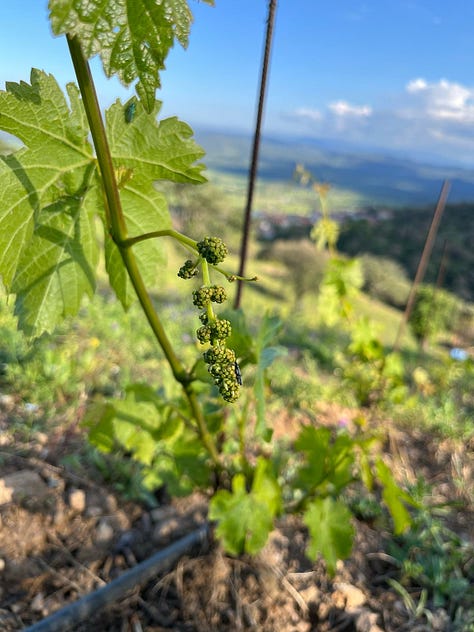
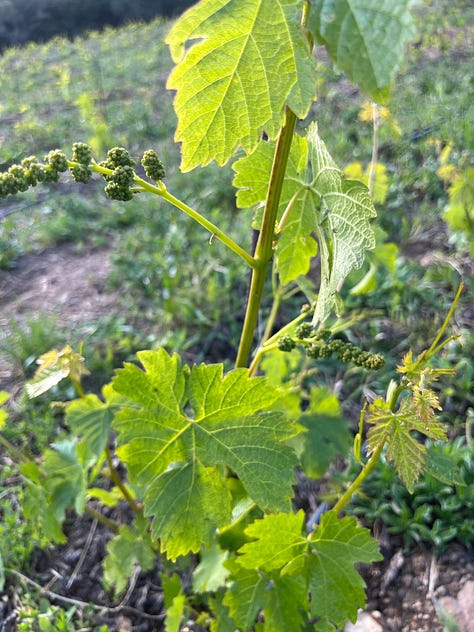
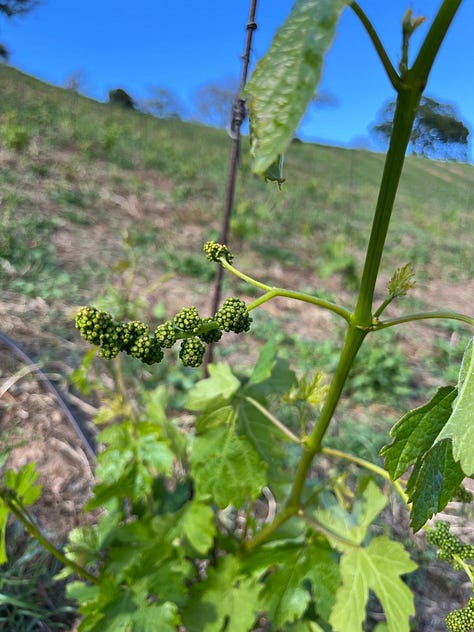
If you want to learn more about bud break, flowering, and fruit set, check out this article on Sip with Nik.
This week with the help of some friends, Marco is putting in all of the vineyard posts and trellising that we never got around to setting up. The irrigation that draws from on-site wells has been set up since we planted. But it will be nice to get that hooked up to the trellising so it’s no longer on the ground.
I’m very much looking forward to our first harvest (hopefully this year) and starting to experiment with some micro-vinifications to explore the various sites and varietal expressions. I’m also excited to grow into our own winery space eventually, which will include building our small winery, as well as renovating some of the buildings we have available near our vineyards for a tasting room or other experiences.
One day we’d love to host guests for wine and food experiences, and potentially renovate some of the older homes in Anela into a bed and breakfast. We shall see what the future has in store!
A Reflection: Beauty in the Details
Planting this vineyard has been full of lessons in patience and determination. We’ve had to overcome several challenges from the heavy Italian bureaucracy to drainage issues that caused flooding and destroyed about a thousand newly planted vines. And on top of that, we’ve had to return intermittently to America in order for my husband to retain his green card, which has made holding down a full time job consistently difficult for him.
Starting a dream from scratch requires a lot of heart and perseverance, but I’m remaining hopeful it will all be worthwhile some day. This journey has also opened my eyes to the slower, intentional living that’s so common in Sardinia and can be so good for the soul if we let it.
Thanks to everyone who voted for the live vineyard Q&A in my last vineyard focused newsletter. I will be heading back to Sardinia towards the end of May and I’m hoping we can make it happen then! Stay tuned for updates.
My next vineyard update will probably be around that time as well, since I will be back in Sardinia and can share more of my first hand experience while there.
Please leave a comment below with any questions about vineyard planting, our grape varieties, or even starting a wine journey of your own!
P.S. We’re up to 11 donkeys now with 2 new babies this year (one born yesterday)!









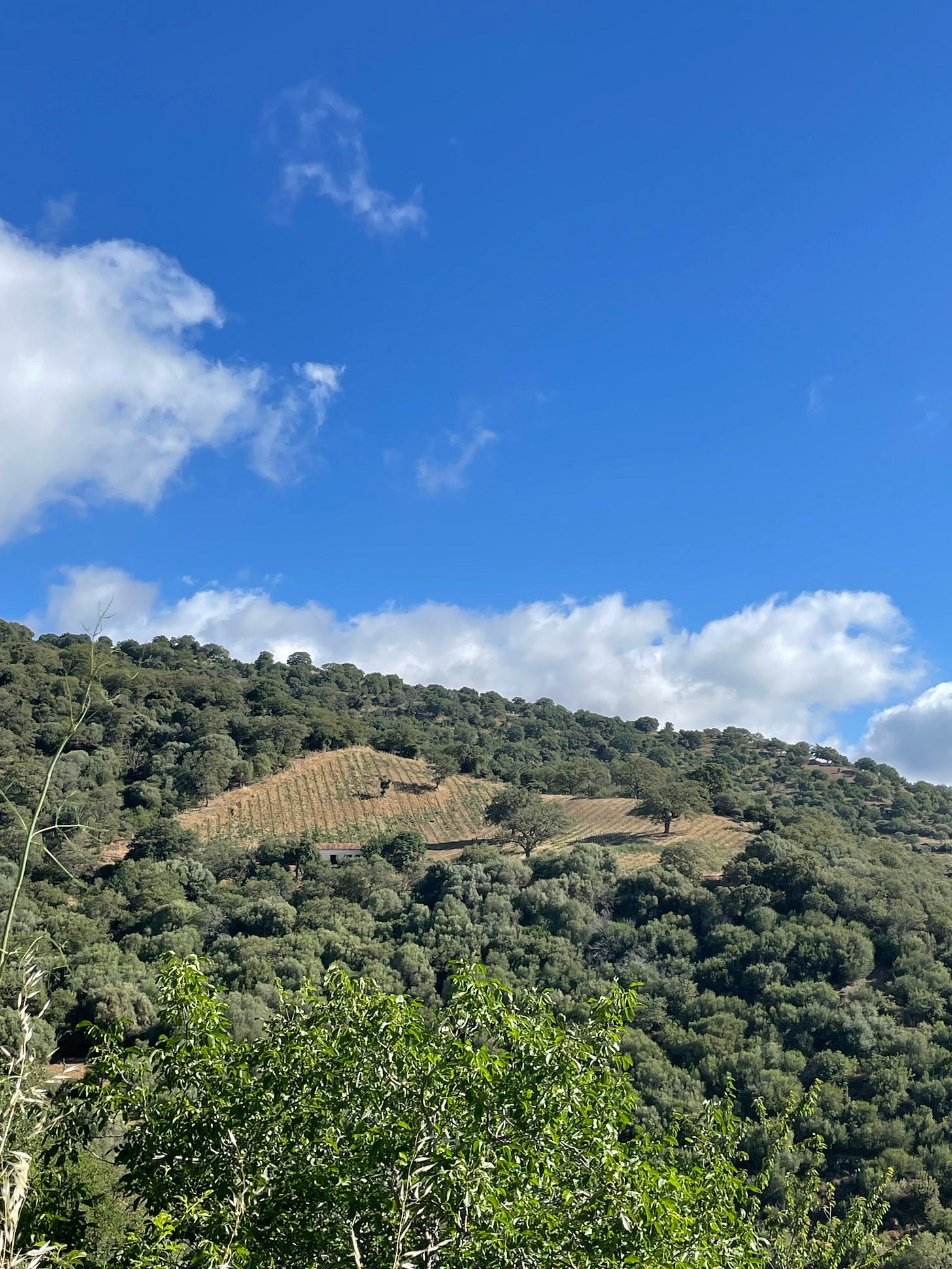




This was a great deeper look- thank you for sharing!
Great post. You can never have too many donkeys.